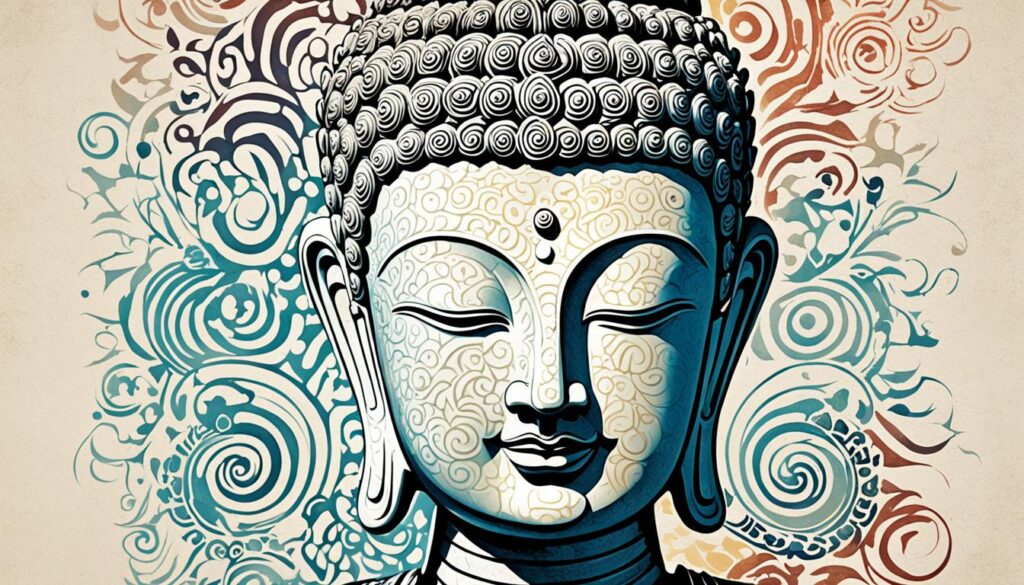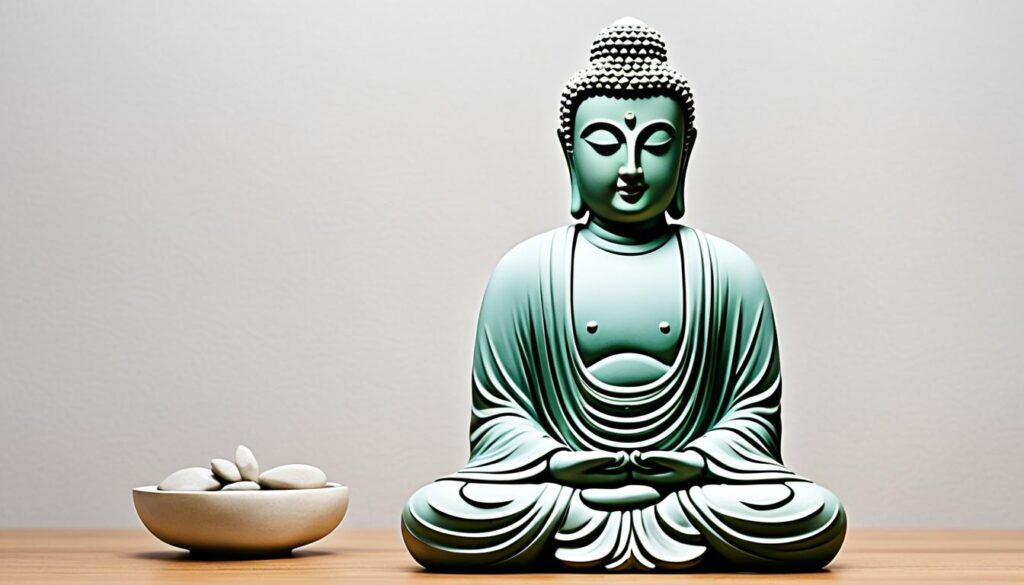The modernist Buddha sculpture brings together deep spirituality and modern art. It shows a new way to see Buddhist icons. As we look into this interesting style, we’ll see how it reflects today’s ideals and thoughts. Important artists and movements have shaped this new buddha art. We’ll explore the rich world of artistic buddha sculptures. The book “Buddha in Contemporary Art” by Ronit M. Lichtenstein helps us understand their impact on society.
Modernist Buddha sculptures are not just nice to look at. They make us think about how tradition and new ideas can blend in art.
Key Takeaways
- Modernist Buddha sculptures combine spirituality with contemporary art forms.
- Cultural influences play a crucial role in shaping artistic buddha sculptures.
- Key artists contribute significantly to the evolution of contemporary buddha art.
- Resources such as “Buddha in Contemporary Art” provide insights into these works.
- Modernist sculptures challenge traditional representations of Buddhist icons.
The Allure of Modernist Buddha Sculpture
The fascination with modernist Buddha sculpture arises from its unique ability to harmonize the fusion of art and spirituality. This captivating genre showcases how traditional Buddhist symbolism can manifest through innovative artistic expressions, attracting diverse audiences and enriching cultural landscapes.
Understanding the Blend of Art and Spirituality
Modernist interpretations of Buddha sculptures emphasize a deep integration of art and spirituality. Artists draw upon age-old motifs yet reimagine them in contemporary contexts, creating pieces that resonate on both aesthetic and spiritual levels. The allure of modernist buddha sculpture lies in its ability to evoke tranquility and reflection, inviting observers to explore their own paths to enlightenment.
The Transformation of Buddhist Art Through Time
The evolution of buddhist art has traversed numerous phases, from ornate depictions in ancient temples to the sleek lines of modern installations. This journey reflects broader art movements, where influences from Minimalism, Abstract Expressionism, and other styles have reshaped traditional forms. Each piece tells a story of its era while maintaining its spiritual essence, showcasing how art serves as a bridge for cultural dialogue.
| Period | Key Characteristics | Artistic Influences |
|---|---|---|
| Ancient Buddhist Art | Intricate designs, narrative storytelling | Religious texts and folklore |
| Medieval Era | Iconic religious imagery, regional styles | Cross-cultural interactions, trade |
| Modernist Movement | Simplified forms, abstract interpretations | Minimalism, Abstract Expressionism |
Defining Characteristics of Contemporary Buddha Art
Contemporary Buddha art stands out with unique features. Artists blend minimalism and abstraction, offering new spiritual insights. These styles, especially seen in minimalist buddha sculptures and abstract buddha figurines, encourage a modern view on spirituality.
Minimalist Approaches in Design
Minimalism highlights simplicity in Buddha art. It removes excess, focusing on the figure’s core. Minimalist pieces use clean lines and neutral colors, creating calm. They emphasize the spiritual over decoration, appealing to those seeking peace.
Artists are inspired by minimalism to craft beautiful, meaningful works. These pieces often spark deep reflection and connect with viewers on a spiritual level.
Elements of Abstract Expression
Abstract expression adds depth to contemporary Buddha art. It engages emotions through bold shapes and colors. Abstract buddha figurines invite viewers to see spirituality differently, blending tradition with new methods.
This approach makes art interactive and thought-stimulating. It’s insightful for those exploring art’s evolution. Knowing these details, available at https://bbnewspress.com/, shows how modern creators balance old and new.
The Rise of Unique Buddhist Sculptures
The art world is seeing more unique Buddhist sculptures lately. These pieces mix old styles with new ideas. Artists use different materials and modern methods to breathe new life into this old art. We’ll look at how these sculptures stand out from traditional ones.
Exploring Different Materials and Techniques
Artists pick various materials for their Buddhist sculptures, such as:
- Metal, like bronze and stainless steel, brings a modern yet spiritual look.
- Wood adds a natural, detailed texture.
- Stone shows lasting beauty and a touch of history.
- New materials like resin and eco-friendly composites open up creative possibilities.
Advancements like 3D printing have changed sculpture making. This lets artists design complex shapes that were once hard to make. Using such technology, they push the limits and bring new ideas to Buddhist themes.
How Culture Influences Design Choices
Cultural backgrounds deeply impact the designs of Buddhist sculptures. Artists from around the globe infuse local styles into their work. This results in unique sculptures that reflect the artists’ cultures. For example:
- In Asia, sculptures may include local motifs, showing regional pride.
- In the West, you’ll find a mix of Buddhist icons and modern styles, merging East and West.
This sharing of cultures makes the art world richer. It shows how global connections can inspire creativity in Buddhist sculptures. To learn more about this, check out Contemporary Buddhist Art. It offers insights into how global influences affect local traditions.

Exploring Artistic Buddha Sculptures
Artistic Buddha sculptures are a mix of old and new. They appear in galleries and public places, bringing a fresh view to age-old themes. Artists from around the world add their own touch. This results in a wide range of styles and meanings.
Innovative Displays and Installations
Today, we see Buddha sculptures in surprising ways. Artists make spaces where viewers can dive deep into thought. They use unique materials and methods to stir emotions.
These dynamic displays link ancient wisdom with today’s art. They make us see the old philosophies in new light.
Influence of Global Artists on Buddhist Themes
Artists from across the globe shape how we see Buddhist art. They blend cultural stories with Buddhist ideas. This mix leads to exciting new artworks.
Such works make us think and talk about spirituality now. They push the boundaries of what Buddhist art can be.
Modernist Buddha Sculpture: A New Perspective
The world of modernist Buddha sculpture introduces a unique viewpoint. It combines traditional and modern styles. This fusion of traditional and modern art creates a dialogue between form and meaning. It tells a story that connects with many people. Artists mixing these elements bring new energy to ancient themes. They use new techniques and materials.
Fusing Traditional and Modern Aesthetics
Artists are merging different styles to dive deep into modernist Buddha sculpture. Traditional designs get a new look in minimalism or abstraction. This evolution shows how cultural symbols can change. It also encourages people to see things in new ways. Every artwork is not only about Buddhist ideas but also current trends.
Prominent Artists in the Field
Many famous artists are influencing contemporary Buddhist sculpture. They are known for combining spirituality with creative innovation. These prominent artists of buddhist sculpture are leaders making sure Buddhist teachings stay relevant in modern art.
| Artist | Notable Work | Style |
|---|---|---|
| Richard Serra | Torqued Ellipses | Site-Specific Sculpture |
| Anish Kapoor | Cloud Gate | Contemporary Abstract |
| Do Ho Suh | Home Within Home | Installation Art |
Minimalist Buddha Statues: The Beauty of Simplicity
Minimalist Buddha statues are deep in meaning. They show the beauty in simple design. These pieces are not just art. They remind us to find calm and take time for thought.
Their simple look and peaceful feel fit well in any space. They help bring a minimalist touch to your decor.

Benefits of Minimalism in Home Decor
Adding minimalist Buddha statues to your home has many perks. Here are a few benefits of minimalist decor:
- Enhancing Peace: These sculptures make any room feel calm.
- Simplifying Aesthetics: They help create a space that’s clean and free from clutter. This leads to clearer thinking.
- Central Focus: These statues catch the eye, sparking interest and conversation.
- Versatility: Their simple beauty fits well with many styles of decor.
The clear beauty in these minimalist Buddha statues speaks to many. Those who want balance and harmony in their lives are drawn to them. Choosing these statues turns a home into a peaceful retreat.
Innovative Buddha Statues: Pushing Creative Boundaries
Innovative buddha statues combine old artistry with new creativity. Artists now use new methods in sculpture that change old norms. These changes redefine what the figures mean. By using things like augmented reality, they make the art interactive. This encourages people to explore and connect with the art.
Techniques That Redefine Sculpture
Artists are using unique materials and methods in Buddhist art. They use recycled items to show the importance of nature and caring for the environment. This new approach changes how symbols are shown in art. With tools like laser cutting and 3D printing, artists can make detailed designs that were once impossible.
The Role of Technology in Contemporary Art
Technology has a big effect on art, changing how it’s made and shown. Artists bring digital experiences to sculptures, making the art more interactive. This change helps include more views on enlightenment, showing modern values like equality. Such changes make discussions on spirituality and creativity more relevant. For more on how modern ideas blend with traditional ones, see this resource.
The Impact of Sleek Buddha Designs on Modern Living Spaces
Sleek Buddha designs uplift modern living spaces. Their smooth lines and minimalist look add peace and beauty. They turn rooms into relaxing spaces with style. Think carefully about where to place them in your home.
Choosing the Right Piece for Your Home
Finding the right Buddhist decor needs thought on many factors. You want it to match and enhance your room’s feel. Size, material, and style are key:
- Size: Pick a size that fits without taking over.
- Material: Decide between ceramic, metal, or wood for different vibes.
- Style: Ensure it matches whether your room is modern, cozy, or classic.
Creating a Zen Environment with Art
To make a zen art space, plan your layout and art placement. These steps help make your home more serene:
- Use a sleek Buddha as a focal point to catch the eye.
- Set up furniture to encourage a nice flow and balance.
- Add nature with plants or water features near your art.
Combining these ideas creates a calming space and boosts your living area’s look. Choosing sleek Buddha designs lets you make a peaceful and welcoming area. It helps relax your mind and lift your spirit.
| Design Element | Considerations |
|---|---|
| Size | Pick something that’s just the right size for the space |
| Material | Choose a material that fits with your decor style |
| Style | Ensure the Buddha matches the theme of the room |
Conclusion
The exploration of modernist Buddha sculpture shows a mix of art and spirituality. This summary points out how artists today build on Buddhist themes. They push the limits creatively while keeping the core values. We see more interest in simple designs and new installations. Because of this, Buddhist art’s future seems bright, aiming to foster mindfulness and peace.
Modern Buddhism in art is very important. By blending old and new styles, these works keep their deep meanings. They also attract those who seek peace in these sculptures. This journey into Buddhist art leads to a deeper spiritual connection in our daily lives.
Looking ahead, we expect to see more innovation in Buddha sculptures. Artists are trying out new materials and techniques that shape this art form. It’s a chance for all of us to dive into this artistic movement. We can embrace its impact in making our surroundings more mindful and peaceful.